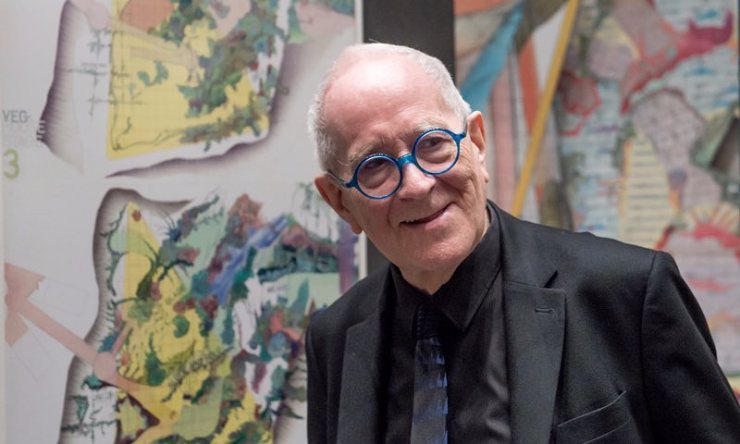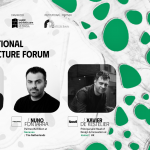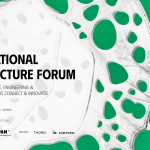Peter Cook’s Advice at SHARE Bucharest 2020 Forum: ” We need to use ingenuity!”
SHARE Bucharest 2020 Forum welcomed, on 15th of October, Sir Peter Cook, the notable English architect, lecturer and writer on architectural subject. For the first time during a SHARE conference, as well as addressing a Romanian audience, Sir. Peter Cook draw the conclusions of the evening, after a 10-hours architectural marathon. Through the virtual medium, excited, yet taken down by not having the chance to meet face-to-face, we all listened carefully to the words of the Sir. Peter Cook and whilst being transposed into his compelling architectural reality.
Arch. Alexandru Găvozdea, arch. Emil Ivănescu, and arch. Șerban Țigănaș were the first ones to ennoble his views and ideas by starting a short discussion on what the future of architecture holds. In the paragraphs below, we invite you to read a few ideas from this discussion. We do not want to reveal too much, but as you will browse through the words below, keep in mind that “We will have to design more things with different combinations, and as I come back to the central theme, we need to use ingenuity. It’s forcing us to be ingenious. It’s forcing us to be inventive, not just those people who say, “I have the standard formula for doing a house. That’ll work, that will work, that will work.” No, you’ve got to think again, and I like that challenge”.
We invite you to follow the presentation of arch. Sir. Peter Cook and the subsequent discussion with arch. Alexandru Gavozdea/ president of the Order of Architects Romania, arch. Emil Ivanescu/ president of the Bucharest Territorial Branch of the Order of Architects Romania, and arch. Serban Tiganas/ General Secretary of UIA. Below you will find the transcript of the discussion at the end of the conference.
Emil Ivănescu: Thank you very much for your presentation. It was very interesting, your idea of fascination about losing things in the garden. I think you make a kaleidoscope of ideas in the cities. The question could be if you see this reinvention of the city in the notion of the ambiguity of the play with the ambiguity of different identity or different textures between built and built vegetation, artificial and so on.
Sir Peter Cook : I think you caught the general idea. It’s difficult in half an hour to summarize all in one because I’ve been deliberately making a collage of probably 40 years of different things. It is interesting being asked to talk about the city. I do not believe that there is a single answer. It’s great to have heroic projects of the past or even in the present that claim there is a predominant answer.
I think that we need, in these or any circumstances, to use our ingenuity. I think in architectural schools, which I know a lot about, not enough people talk about common sense, not enough people talk about ingenuity. They might talk about mannerism, they might talk about style, they might very much talk about what they think you ought to be doing now. Some people say you must be able to digitalize brilliantly and amazingly manipulate any material. Somebody else will say, no, you must take sociological aspects as a priority. Somebody else saying, no, no, no, what is important is the threshold.
I think we need to use total ingenuity. If we were like the guy Robinson Crusoe isolated on a desert island, he wouldn’t be too purist about it. You’d use whatever came to hand. Intellectually, I like that. I think one should use whatever comes to hand in your brain non-exclusively.
Emil Ivănescu: I would like to ask you something because you design very peculiar, very special buildings. We have lots of problem in Romania about heritage, about building in this context. How do you see this idea?
Sir Peter Cook: We have it just as much in London. I think everywhere you go; heritage is Meritage. I think that we preserve a lot of crap. In London, I remember saying once there were one or two friends of mine who had done very interesting things.
Just going back a little while, but I remember quoting three friends of mine, Peter Wilson, Ron Herron, who’s now sadly dead, and Ron Arad, they all did buildings in a similar bit of London, but you can’t see them from the street. If you are allowed near, or if you are allowed into the courtyard or somehow, “Oh, my God, this is really interesting”, but the city didn’t want it. They are three of the most brilliant designers I’ve known.
We’re not allowed to show what they were doing. They had to hide like somebody hiding a dirty magazine or something. We did. I can give you a very specific example. In Graz where we built the Kunsthaus, one of the things was that we had to preserve a piece of elevation. Very important. It was a hundred and something years old. It was the earliest cast iron south of the Alps or whatever the hell it was. It cost millions of euros to prop it up. Great expense to prop this piece up and then we could build around it.
We found it had been brought in from England. It was a prefabricated thing sold in Sheffield. The guys in Austria bought it. It came on the back of ponies or how the hell it got there. It was now considered a piece of Austrian heritage. I laughed like a drain, I said it’s some shit faces in Sheffield who were onto a good thing sold the Austrians these bits of metal, it doesn’t matter. As soon as it’s there for a hundred years, it becomes heritage. I’m very cynical about this. I think yes and no, I wouldn’t tear everything down, and I live in a 100-year-old district now where you’re not allowed to even change the front window, and you have to paint it in a certain way. It’s very nice. It’s a very nice bourgeois with lots of trees, but I think you could introduce a few slightly naughty windows without the whole thing collapsing. It’s a tricky one, but my God, I don’t think your Bucharest edicts can be any stiffer than they are here. Everybody is paranoid about keeping stuff, of which I would say 40% is crap but it’s old. The other 60 is discussion.
Alexandru Găvozdea: Thank you very much for your very inspiring presentation. It was indeed a collage of a lot of different and very, very interesting projects, thoughts, and maybe even challenges, especially when you addressed a little bit in the beginning and then right at the end of your presentation, the future of living in a city, of urban living. Obviously, people are attracted to cities. We know that, and the migration towards cities is ever-growing. We’re looking at maybe getting to 70% urban population within the next few dozen years.
In the context of the current pandemic, and maybe we should get prepared for similar situations where we cannot cope with what nature wants to throw back at us. Do you think that there is really a good potential for remixing the also separated programs of functions of the city on the small scale in order to help people get away from the cars, get away from the enormous surfaces of land that they are using for, not really functions, but just mere commutation needs? Do you think this would be a solution to try to find a way to just, I don’t know, walk or bicycle to work, to the shop, to the market, and not commute all the time?
Sir Peter Cook : I think we see it happening now. The lockdown, I have one building on the go in a provincial town in England, a university building, small one. I, being an old person, I’m 83, I don’t want to risk going down to Bournemouth in a train or even in a car. Maybe in a car, but then you have to stay over. A much younger person than me does it for me. Then he works at home, I work at home. A third person involved also works at home.
We commute occasionally once every two weeks. He has to come around with a drawing that we can’t transmit. This is very rare, and it’s nice to see him. We’re all masked up and so on. We seem to be doing it. The building is moving more slowly than it would have done, but 50% is moving maybe 30% more slowly, but it’s happening. The steelwork does seem to arrive. The specialists do seem to come on a bicycle or however the hell they get there. It raises the point, why we don’t really need an office, not at this scale.
I do lectures, I don’t need to be in the school. I’m doing a whole series of lectures. I prepare them here. I would like to see the person sitting in the front row if they’re picking their notes or grinning or something, it helps me give the lecture, but I can’t. I think that on the other hand, this would be what was said a little bit earlier, I think the tendency towards more and more and more and more people in the city, the pandemic may just have an effect of slightly leveling it off, which probably is no bad thing. The pandemic’s disastrous, and I’m endangered species, but it may be useful that it’s done that. The other thing is I certainly think that, and I was saying so in my lecture, the notion of typologies is only so good so far. I know that in German schools for architecture, in particular, every student has to know what the city house is, what the village house is, what the apartment is, and so on. Many of them say, “Okay, now I know how to do buildings.”
The notion of the guy who builds canoes on the ground floor, and then somehow that gets into making, let’s say, shower compartments, though he used to make canoes, and his sister on the top floor is working as a graphic designer, but also gets into making objects for children. Then, somebody else moves in and says, “Since you’re making shower compartments, I’m going to make taps, but I’m only down the street.” This kind of thing, it was perfectly acceptable in the 19th century, still perhaps acceptable in a few communities.
Here, I was watching your Schüco window advert that I had to sit through. We’re using Schüco windows on the building that we’re building. I hear a lot about Schüco buildings every week. They come from Germany, and that’s very nice. I have fantastic admiration for German windows. If you want to stay comfy, have a German window. Of course, it raises the issue, could Joe Smith down the street make a window, anything as good as Schüco can make it? Frankly, no. Is there a trade-off?
The better and better that master Schüco gets at making their window. Then probably having to open a factory in Taiwan or in Vietnam or somewhere in order to make the window cheaper than the German workers, and still it’s having to make its way right down to Bournemouth so that we can put it in the wall, it’s an interesting issue. I’m no economist, but I am also a realist. I think we can only go so far with the villagization of the city. Those of us who are privileged enough to have trees outside our window, and a garden to escape to, and supermarkets who are willing to send a bloke down in a van if I suddenly want a bottle of white wine or a leg of lamb, it’s wonderful, but to what extent can it be reproduced?
I still think that we haven’t– There’s another issue about the house. In my training and in the books and government regulations that I’ve had to use in the past, it was presumed that the family, the father was shaving at a certain time, and they gave you tables of when most people are shaving. When most people are watching television. How much space somebody needed in order to cook. How much space the kid who was doing their homework needed. It was always running 30 years behind what actually happens.
Now, we also have the aspect of physicality and theater. I’m sitting in front of you on this screen with a nice shirt on. I put the shirt on, especially, for you because it’s like going and doing a real lecture. I might be sitting in my underpants. There might be absolute shit all over the floor. You can only see the nice wall behind me. It used to be my son’s bedroom. He has a whole collection of soft toys that we’ve made into an art piece, and it has some of my drawings on the wall. You don’t know what else is in the room. It’s equivalent of dressing up to go to a party. It’s a very interesting one because it makes one think about the room very differently from how we thought about it half a year ago.
The same with the street. I now have to enjoy my immediate area where I go for walking, which is Bourgeois’ Streets. My wife starts photographing plantations, and we start looking at people’s windows in a way that we never used to just go past and say, “Yes, it’s down the road.” Now we’re looking at it as if it was a whole city. We’re looking at Lower Hampstead as if it was a complete metropolis. Actually, we would go mad if we didn’t, but it’s interesting. Makes you look at the positioning and scale of things. That was the corollary between that and this notion of activity. At this moment, I am working, but I don’t have to go into an elaborate process between that and then sleeping. As soon as I switched your thing off, I can lie down here, and I can get through a couple of glasses of wine, I can gossip with somebody on the phone, but I can’t see them.
In former times, I would have to fly to Bucharest, stay in a nice hotel, go sightseeing, meet a few new interesting people, update my fascination with Bucharest, which is with those very weird spaces you have between streets which I’ve never got my head around. They’re very particular to Bucharest. I’d love to do that. No, I’m seeing a bearded man on the left, a guy in a grey suit on the right, and a guy with a mask and a white shirt behind you. It’s pretty poor stuff.
On the other hand, I can switch it off and I don’t have to get on the airplane. We will have to design more things with different combinations, and as I come back to the central theme, we need to use ingenuity. It’s forcing us to be ingenious. It’s forcing us to be inventive, not just those people who say, “I have the standard formula for doing a house. That’ll work, that will work, that will work.” No, you’ve got to think again, and I like that challenge. That one is a long one.
Alexandru Găvozdea: Thank you very much. We are very honored that you want to come in Bucharest.
Sir Peter Cook : My wife has– We used to have a relative in Bucharest. They died.
Serban Tiganas: I’m lucky. I’m on the shortlist of people who have the chance to address your question, Mr. Cook. I was wondering what kind of question if I have this chance. I would rather ask my students. Finally, I got this book you certainly know, which I bought in London, 2008, the year it came out. I would like to ask you about drawing because you presented fascinating drawings. What do you think about the future of drawings? This will still stay the motive force of architecture? How do you see it now after 12 years?
Sir Peter Cook : What I have to say, a great pity you bought the first. There’s now already some time ago, a second edition of the same book. I’ve added in about 30 pages discussing the implication of the digital or the computer-based drawing. Largely discussing it with certain good friends of mine who are really into that and produce beautiful things. I think that, and I have this conversation very often with my wife who’s also an architect. In fact, she’s out in the garden photographing me now as I speak.
She always said she was not a good drawer, she was a model maker, and she worked all her projects out mostly in models, and with difficulty, learned to draw. We had, in London, a very particular drawing syndrome, let’s say 30 years ago. It was a mixture of pedantic drawing and romantic drawing, and everybody at the at the bartlett, everybody draws pretty well. Sometimes when I visited other places to visit architecture schools, some places like Tel Aviv or somewhere where they drew with their foot, the drawings were terrible
I found it very difficult to take the work seriously if it was badly drawn. Now, that is an admission of a failure, that is an admission of narrowness of mind, because it is possible to produce a good building with the minimum– I think Schindler only drew apparently on the plasterwork what he wanted to happen, and he did a fantastic building. It’s an intriguing one because I think the great thing about drawing is that you can predict the impossible. You can conject the impossible. You can mix a piece of pedantic neo-realism with a piece of pure fantasy on the same drawing. You can say, this thing may be like that, but when I do the next drawing, it may be like that. Of course, the computer, I can’t do it, but the computer can also do this. It can deal with time and flow.
I think predictive designing, or designing alternatives, rolling alternatives over each other, collaging, then saying, “Okay, freeze, that’s what we’re going to build tomorrow”, is fascinating. I do not see any dividing line between drawing and making. As we speak, and I’m not going to show, it’s not good enough, I’m making an aluminum structure in our garden. I’m making a gazebo. I’m still young enough to drill aluminum, thousands of drill holes, and screws. This thing, I did draw it.
My client is my wife, so she’s demanding, but I did draw it. There was a certain point at which I stopped drawing and start making. As the thing must be adjusted structurally, I’m inventing on my feet. I sit on a sit looking at it and saying, it’s doing something wrong there. That to me is a drawing, it is a drawing. I’m approaching it in the same way that I would a drawing. It happens to be something you have to hold in my hand and drill and screw with a screw, but it’s a drawing. I don’t see you dividing.
The other thing just before I finish, is that when I first started at architecture school thousands of years ago, I was not a good drawer. There were other people, even in the little school I was at who were better drawers. They could draw dogs and trees, and I was very tempted to draw. I was determined to draw. I was determined to somehow find my way to do it. I’m still a systematic drawer. I’m not a sort of, there’s a dog, there’s a tree. I know my sketchbooks are not good. They are organizational.
While I was waiting watching the adverts, I’m scribbling something there, which you see is a very simple scribble. It’s an idea of something. The fountain pen is wonderful. It allows me to drift. In one lecture, I do I actually have filmed myself drawing with the fountain pen. Recently, the Bartlett school has bought me a wonderful device here, just off-screen, which will allow me to be drawing on the camera, which will then go on the Zoom. It’s a way of thinking.
Drawing is a way of thinking and experimenting and putting the unlike with the unlike. Whereas of course one of the conversations I have with digitally-based people, is I say, your damn digital thing is only doing what is correct. There was a wonderful piece of gossip that went around 15 years or more ago, where it was said that in the early days of the late Zaha Hadid’s office, they were doing incorrect drawings because the Apple computer hadn’t got us very sophisticated at that time. This is probably 20 years ago, whenever it was.
I don’t know whether it’s true or it’s a fiction, but it’s a wonderful notion that as soon as the computer started to get more sophisticated, it stopped them doing naughty things with it. I can still remember extreme long time ago when I first started using a Xerox machine, that you could do naughty things if you pulled the paper and distorted it. I’m all for things that aren’t quite correct. I think that can apply outside drawing. The drawing, what it was is the struggle to become an adequate drawer. It forced me into certain tricks. I have certain tricks and certain things I can’t do, and so I do the things I can do, more and more. There’s a lot of conversation there, but what was interesting doing the book, and particularly the second edition of the book, was actually talking to people who I admire and looking at their ways of drawing.
Serban Tiganas: Thank you so much. I’m delighted.
Alexandru Gavozdea : Thank you very much, Sir Peter Cook. It was a great honor having you with us. I think my major takeaway from this session is that we have an actual responsibility of having ingenuity put up in the first place. Find the best solutions for the challenges at hand, whatever the particular context may be, and not fall back only on rules, regulations and predetermined recipes for success, or may it be failure. Thank you very much for your speech. A lot of wisdom.
Sir Peter Cook : You got the message.
Alexandru Găvozdea: Thank you. It’s a great confirmation. We hope to, rather sooner than after, welcome you physically in Bucharest, and maybe have a look at the back side of the streets that you’re so intrigued about. Thank you.
Sir Peter Cook : Thank you.



